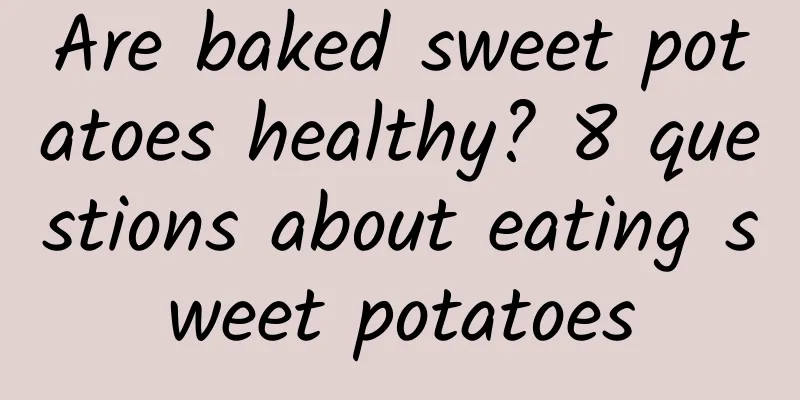Are baked sweet potatoes healthy? 8 questions about eating sweet potatoes

|
In winter, everyone will fall in love with hot roasted sweet potatoes. It is fragrant and sweet, and the charm of food is irresistible. One day, my students and I made delicious food together during a regular meeting. One of them was a baked sweet potato made in a microwave + air fryer. After posting it online, it attracted many questions: I heard that roasted sweet potatoes will produce a lot of acrylamide? Will using an air fryer to bake sweet potatoes cause internal heat? What is the difference between purple sweet potato and sweet potato? Can raw sweet potatoes be digested? Is it better to steam or roast it? Can diabetics eat baked sweet potatoes? Will eating baked sweet potatoes make you fat? I heard that sweet potatoes can’t be eaten on an empty stomach? Here I will tell you some food knowledge about sweet potatoes. If you don’t want to read the knowledge points, you can directly scroll to the end of the article to see the question summary. Knowledge Point 1 What pigment gives sweet potatoes their color? Sweet potatoes are a type of sweet potato. Sweet potatoes have a variety of skin and flesh colors, ranging from pure white, light yellow, orange-yellow to purple. They are called white potatoes, yellow potatoes, sweet potatoes, and purple potatoes. There are even "flower" potatoes that are purple and white. Yellow and orange come from carotenoids, especially beta-carotene; while purple comes from anthocyanins, and the majority of anthocyanins are cyanidin. Knowledge Point 2 How much starch and sugar are there in sweet potatoes? There are many varieties of sweet potatoes. Some are particularly rich in starch , with a starch content of nearly 30% and relatively little reducing sugar, which is suitable for extracting starch and making vermicelli. Some have a starch content between 10% and 20%, but a relatively high reducing sugar content , which can reach 10% to 20%, and taste sweeter. Such sweet potatoes are suitable for fresh consumption. Some scholars have tested 28 sweet potato varieties and found that the soluble sugar content was between 3.5% and 7.0% when they were just harvested. The starch content varied greatly, ranging from 10% to 31% (Xie Ziyu et al., 2021). Knowledge Point 3 Why are sweet potatoes sweeter in winter? Soluble sugars are those that can dissolve in water. They include small molecule sugars such as glucose, fructose, sucrose, maltose, lactose, and even oligofructose. All sugars that make people feel sweet are soluble in water. For fruits, vegetables, and potatoes, the higher the soluble sugar content, the better they taste. In winter, due to the lower temperature, plants will break down some starch into soluble sugars to increase osmotic pressure and resist the harm of low temperature and freezing. Therefore, after being stored for a period of time in autumn and winter, the sugar content of sweet potatoes will be significantly higher than when they were just harvested, making baked sweet potatoes sweeter. Knowledge Point 4 There are different types of digestible starch in sweet potatoes In addition to sugar, sweet potatoes also contain starch. From a digestion perspective, starch is usually divided into three parts: rapid digestive starch (RS), slow digestive starch (SDS) and resistant starch (RS). Fast-digesting starch can be digested by the human body and can quickly increase blood sugar. For people with indigestion, fast-digesting starch can reduce the burden on the digestive system and provide them with energy more quickly . But for people who need to control blood sugar, eating too much fast-digesting starch at once will be a big test for their ability to control blood sugar. Slowly digestible starch can also be digested and can release energy slowly, but because it is digested slowly, blood sugar rises slowly, which is beneficial to stabilizing blood sugar after meals. Resistant starch is unlikely to be digested and absorbed in the small intestine, and will hardly raise blood sugar levels. Instead, it enters the large intestine and is broken down and used by microorganisms to produce gas and short-chain fatty acids . A small amount of resistant starch can improve intestinal flora and help control blood lipids, but a large amount of resistant starch may cause gas production, bloating, and indigestion. Raw sweet potatoes can be eaten, and the reducing sugars in them are digestible. However, because they contain a high content of resistant starch and a large proportion of indigestible ingredients, they do not raise blood sugar levels after a meal, so eating too much can cause bloating. Knowledge Point 5 After cooking sweet potatoes, starch and carotene are better absorbed A study found that steaming yellow-fleshed sweet potatoes for 35 minutes slightly reduced the sugar content, while microwave heating for 5 minutes increased the sugar content (compared by the content in the sample dry weight). Boiling also increases the sugar content, but because some of the sugar will dissolve in water, it does not feel as sweet. Researchers believe that microwave heating may promote the degradation of starch, producing more glucose and maltose. Steaming, boiling, and microwaving can all reduce the proportion of resistant starch in sweet potatoes by more than 60% , and increase the proportion of fast-digestible starch from less than 10% in raw sweet potatoes to more than 30%. However, the changes in slowly digestible starch are different. During cooking and microwave treatment, the proportion of slowly digestible starch decreased from 8% in raw sweet potatoes to less than 1%. However, the slowly digestible starch retention rate of steamed sweet potatoes was higher, reaching about 7% (Lei Huanna et al., 2019). Therefore, when sweet potatoes are cooked, most of the starch can be digested by humans, and the reducing sugars in them will increase blood sugar levels. In comparison, when they are boiled or microwaved, blood sugar levels may rise faster. However, microwave cooking also has an unexpected benefit, after cooking, the carotene content increased by nearly one-fold. In fact, this is not surprising, because it may be because the combination of carotene and protein is broken down after microwave cooking, and can be better released from cells, so the actual amount obtained will increase. Knowledge Point 6 What are the nutritional differences between sweet potatoes of different colors? Some scholars have found that the taste and flavor of sweet potatoes are positively correlated with the content of beta-carotene, protein and starch. In other words, for yellow-fleshed sweet potatoes, the more orange-yellow the color, the better they taste. For purple-fleshed sweet potatoes, the higher the anthocyanin content, the worse they taste; the higher the sugar content, the better they taste. An analysis of the color and composition of 28 varieties of raw sweet potatoes found that the total polyphenol content ranged from 28 to 117 mg/100 g, with the purple variety being significantly higher than the yellow variety. The carotene content is between 0 and 9.8 mg/100 g. 9.8 mg/100 g is higher than that in ordinary carrots! Therefore, eating sweet potatoes with orange-yellow flesh is a good way to supplement carotene, just like eating carrots. The test also found that purple sweet potatoes have a strong inhibitory effect on trypsin activity, and the higher the polyphenol content, the more effective it is in inhibiting protease. This can explain why eating too much purple sweet potatoes can easily cause stomach blockage and bloating, which is quite unfriendly to people with indigestion and gastrointestinal diseases. Knowledge Point 7 Do baked sweet potatoes produce carcinogens? How much acrylamide do they contain? Baked sweet potatoes, like baked potatoes and fried potatoes, will produce acrylamide when cooked at temperatures above 120 degrees Celsius, with the highest acrylamide production at 160-180 degrees Celsius. This temperature range is exactly the temperature used when food is baked and fried. However, compared to French fries, the acrylamide content of baked sweet potatoes is still much lower. Although people do not want to eat too much acrylamide, it is difficult to stay away from it. This is because acrylamide is a side reaction produced during the Maillard reaction . Fried dough sticks, French fries, and popcorn chicken turn yellow when fried, bread, biscuits, cakes, and sesame cakes turn brown when baked, and roast duck and roast chicken have a bright red and fragrant surface after roasting... These are all caused by the Maillard reaction. Generally speaking, for the same food, if the degree of Maillard reaction is higher, the brown color is darker after cooking, and the texture is crispier, then the production of acrylamide will be greater. Whether it is deep-fried, oven-fried, pan-fried, or air-fried, the principle is the same. Chinese scholars have tested 7 baked sweet potato samples and found that their acrylamide content ranged from 33 to 201 micrograms per kilogram, while the results of testing 7 French fries samples ranged from 364 to 587 micrograms per kilogram (Meng Juanjuan et al., 2014). This is because compared with sweet potatoes, potatoes have a higher protein content, a stronger Maillard reaction, and a higher content of amino acids such as glutamine that are prone to forming acrylamide. Acrylamide is not a highly toxic substance, and it does not significantly affect health when present in small amounts. Most Chinese residents do not eat baked or fried dishes every day, nor do they eat baked foods such as bread, biscuits, and cakes every day. There is no need to worry about eating a baked sweet potato occasionally. Knowledge Point 8 Why do I feel dry mouth and sore throat after eating sweet potato chips baked in the air fryer? Despite this, some netizens still said that after eating baked sweet potato chips and baked potato strips made in an air fryer, they would feel a little "hot", manifested as dry mouth, sore throat, and even acne on the face. There may be two main reasons for this. First, baked food (including food cooked in an air fryer) has a low moisture content . When eating, the chewed dry food will absorb a lot of moisture from the saliva, oral mucosa and throat, causing local dehydration of the mucosa and dryness and discomfort. Dry and hard food fragments can easily cause small wounds on the mucosa. In addition, the resistance of the mucosa decreases after dehydration, which can easily lead to bacterial infection and inflammation, causing pain and discomfort in the mouth and throat. Second, during the high-temperature heating process of baked food, substances that promote inflammatory reactions are produced , referred to as "pro-inflammatory ingredients". These include some products of the Maillard reaction, for example, acrylamide is a pro-inflammatory ingredient. The end product of the Maillard reaction, AGEs, is also a pro-inflammatory factor. The crispier and more browned the food is, the higher the content of these pro-inflammatory substances. If the temperature is too high, polycyclic aromatic hydrocarbons and lipid oxidation polymerization products will be produced, which are things that promote inflammatory reactions. Excessive intake of pro-inflammatory ingredients can also induce acne or make acne worse. Therefore, if you find yourself having adverse reactions to these overly crispy foods, you need to eat less fried, smoked, baked, and air-fried foods, and also eat less sweets, because they also promote inflammation. When eating, eat more raw vegetables and fruits to go with it. Finally, I will sort out the answers to related questions and talk about how to make quick and delicious baked sweet potatoes. 1 Sweet potatoes contain both starch and soluble sugars, and the content varies greatly between varieties. 2 Sweet potatoes of different colors have different nutritional characteristics . Generally speaking, varieties with orange-yellow flesh are tastier, have a higher content of beta-carotene, more sweet sugar, and are easier to digest. Varieties with purple flesh have a higher content of polyphenols such as anthocyanins and have very strong antioxidant properties; but at the same time, they have a stronger ability to inhibit digestive enzymes and are not so friendly to the gastrointestinal tract. 3 When baking sweet potatoes, the Maillard reaction occurs, so acrylamide is inevitably produced . However, compared with baked potatoes, French fries, and potato chips, the amount is much lower. If you don't eat the burnt part, you don't need to worry about safety when eating it occasionally. 4 Baking sweet potatoes in an air fryer is no more harmful than baking them in an oven . The key is not what machine to use, but whether the degree of baking is excessive. Bake until the aroma is produced and the surface is yellow, but not to the extent of being burnt brown and crispy. 5 It is harmless to cook sweet potatoes in a microwave . Cut the sweet potatoes into thick slices, put them in a microwave-safe container such as a glass/ceramic/plastic box with a lid, add a spoonful of water to generate steam, and then heat on high heat for 6 to 8 minutes to steam. It is much faster than an ordinary steamer, and it is timed and does not require human supervision. 6 Steam the sweet potatoes first (either in a regular pot or in the microwave as above), then put them in an air fryer or oven tray, flatten and bake. Fry them in an air fryer at 180-200 degrees Celsius for 15-20 minutes, or in the oven for 30-45 minutes. This way you can quickly eat baked sweet potatoes, which are sweeter and more delicious than traditional baking methods. 7 Raw sweet potatoes can be partially digested, but they are difficult to chew and contain a lot of resistant starch that the human body cannot digest. At the same time, raw sweet potatoes contain ingredients that inhibit digestive enzymes. Eating a small amount is fine, but eating a large amount may cause bloating and indigestion. Therefore, it is better to eat sweet potatoes after cooking. 8. Compared with ordinary steamed sweet potatoes, microwave steamed sweet potatoes and baked sweet potatoes, ordinary steamed sweet potatoes have more slowly digested starch and slightly less potential to raise blood sugar . For people who need to control blood sugar, steaming may be better. Compared with steamed sweet potatoes, baked sweet potatoes take longer to heat, have a softer texture, and have a high content of quickly digested starch, which is not conducive to blood sugar control. 9 Digestion speed and blood sugar response are related to the variety of sweet potatoes . In theory, the softer, sweeter, and higher in sugar content the sweeter and softer they are roasted, the faster blood sugar rises after eating them. For example, the "honey potato" variety that is popular in the market now is not only very soft in texture, but can even produce sugar juice when roasted, so this kind of roasted sweet potato cannot be used to replace whole grains and beans. 10 Eating baked sweet potatoes outside of three meals will promote weight gain because more calories are introduced. If the same amount of baked sweet potatoes is used to replace cooked rice, it will not cause excessive calories because the calorie value of baked sweet potatoes is not higher than that of cooked white rice when calculated by the same weight. 11 Sweet potatoes are foods that stimulate gastric acid production . People with excessive gastric acid should eat less sweet potatoes, especially avoid eating a lot before meals. Purple sweet potatoes have a strong inhibitory effect on digestive enzymes, so people with insufficient gastric acid and insufficient gastric motility should avoid eating a lot. It is okay to eat a small amount at a time with other staple foods and vegetables. 12 People with healthy blood sugar and no gastrointestinal diseases are suitable for eating all kinds of sweet potatoes . Since potato foods are rich in potassium, dietary fiber, and antioxidants, they are beneficial for reducing inflammatory reactions, so they are very suitable for patients with hyperuricemia and gout, as well as patients with hyperlipidemia and hypertension. When eating, just pay attention to reducing the amount of staple foods such as rice and steamed bread. In short, every kind of food has its own advantages and disadvantages, and sweet potatoes are no exception. If you eat it, your body will tell you what effect it has on your health as long as you experience it carefully. References: 1 Lei Huanna, Li Yan, Cao Zhongna, et al. Effects of cooking methods on the nutritional components of sweet potatoes, Food Science and Technology Development, 2019, 40(21), 27-31+61 2 Xie Ziyu, Wang Keer, Zhao Wenliang, et al. Nutritional composition and biological activity of sweet potatoes with different flesh colors. Journal of Zhejiang Agricultural Sciences. 2021, 33(02): 183-192 Reprint/ Cooperation please contact Weibo/ Official Account: Fan Zhihong_Original Nutrition Information |
>>: Cotton quilt, down quilt, wool quilt...which quilt can best keep me warm in the cold winter?
Recommend
Is it true that schools in Shanghai will start on April 20? It is understood that this is a rumor!
Is it true that schools in Shanghai will start on...
Where to release water in Wuhan at night
Wuhan high-end tea drinking is unique and very un...
With an efficiency of 75%, the photography industry can double the click-through rate of information flow advertising by doing this!
As costume photography is sought after by more an...
Do you know the real reason why lithium battery performance deteriorates?
Lithium-ion batteries are now widely used in mobi...
Appointment with the Starry Sky|Look! The first "star" of 2022
This article is reproduced from Xinhua News Agenc...
Scientists, come on, protect our Xinjiang cotton!
Author: Bug Squad The article comes from the Scie...
Taiyang's new course in 2021: Love Maker
Taiyang's new course in 2021: Love Maker Taiy...
Top Growth Hackers: How to Use Data Experimentation to Build a Growth Engine
Growth hackers are the real source of revenue for...
BYD: BYD has applied for more than 48,000 patents worldwide
According to recent news, BYD released an announc...
[Creative Cultivation Program] Did I invent the air conditioner to save you? Wrong, I invented it to save paper!
Author: Wang Jiangshan, Xu Lai Audit expert: Qin ...
How should marketing campaigns be designed?
The purpose of marketing activities is mainly to ...
Xiaomi's Wang Chuan: Redefining high-end TV with three love letters
Xiaomi has released a new TV. The difference is t...
WeChat chat history backup is charged? Teach you how to migrate chat history for free, the method is very simple
WeChat has been trending recently, and may launch...
Detailed explanation of the working principle of LiveData in advanced Android source code
[[422179]] This article is reprinted from the WeC...
Modern climate change: Missing a woman, missing out on a discipline
Science has no national boundaries and no gender ...









